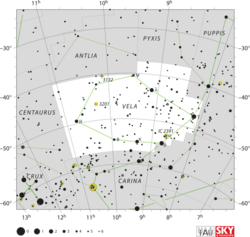Astronomy:Psi Velorum
| Observation data Equinox J2000.0]] (ICRS) | |
|---|---|
| Constellation | Vela |
| Right ascension | 09h 30m 41.99958s[1] |
| Declination | −40° 28′ 00.2616″[1] |
| Apparent magnitude (V) | +3.58[2] (3.91 + 5.12)[3] |
| Characteristics | |
| Spectral type | F0 IV + F3 IV[4] |
| U−B color index | +0.00[2] |
| B−V color index | +0.36[2] |
| Astrometry | |
| Radial velocity (Rv) | +8.8±1.8[5] km/s |
| Proper motion (μ) | RA: −147.98[1] mas/yr Dec.: +61.35[1] mas/yr |
| Parallax (π) | 53.15 ± 0.37[1] mas |
| Distance | 61.4 ± 0.4 ly (18.8 ± 0.1 pc) |
| Absolute magnitude (MV) | 2.56[6] |
| Orbit[7] | |
| Period (P) | 33.95 yr |
| Semi-major axis (a) | 0.862″ |
| Eccentricity (e) | 0.433 |
| Inclination (i) | 58.0° |
| Longitude of the node (Ω) | 291.0° |
| Periastron epoch (T) | 1969.68 |
| Argument of periastron (ω) (secondary) | 44.3° |
| Details | |
| ψ Vel A | |
| Mass | 1.44[8] M☉ |
| Surface gravity (log g) | 4.27[8] cgs |
| Temperature | 7,122±242[8] K |
| Metallicity [Fe/H] | 0.0±0.2[4] dex |
| Rotational velocity (v sin i) | 156.0[9] km/s |
| Age | 889[8] Myr |
| Other designations | |
| Database references | |
| SIMBAD | ψ Vel |
| ψ Vel A | |
| ψ Vel B | |
| ARICNS | ψ Vel A |
| ψ Vel B | |
Psi Velorum, Latinized from ψ Velorum, is a binary star system in the southern constellation of Vela. Based upon an annual parallax shift of 53.15 mas as seen from Earth, it is located 61.4 light years from the Sun. It is visible to the naked eye with a combined apparent visual magnitude of +3.58.[2] The motion of this system through space makes it a candidate member of the Castor stellar kinematic group.[11]
The two components of this system orbit their common barycenter with a period of 33.95 years and an eccentricity of 0.433. The semimajor axis of their orbit has an angular size of 0.862 arc seconds.[7] The primary, component A, is a yellow-white hued F-type subgiant with an apparent magnitude of +3.91[3] and a stellar classification of F0 IV.[4] The fainter secondary, component B, is also an F-type subgiant of magnitude +5.12[3] and class F3 IV.[4] It has been reported to be variable between magnitude 4.5 and 5.1.[12]
References
- ↑ 1.0 1.1 1.2 1.3 1.4 van Leeuwen, F. (2007), "Validation of the new Hipparcos reduction", Astronomy and Astrophysics 474 (2): 653–664, doi:10.1051/0004-6361:20078357, Bibcode: 2007A&A...474..653V.
- ↑ 2.0 2.1 2.2 2.3 Mermilliod, J.-C. (1986), "Compilation of Eggen's UBV data, transformed to UBV (unpublished)", Catalogue of Eggen's UBV Data (SIMBAD), Bibcode: 1986EgUBV........0M.
- ↑ 3.0 3.1 3.2 Malkov, O. Yu. et al. (2012), "Dynamical Masses of a Selected Sample of Orbital Binaries", Astronomy & Astrophysics 546: 5, doi:10.1051/0004-6361/201219774, A69, Bibcode: 2012A&A...546A..69M.
- ↑ 4.0 4.1 4.2 4.3 Heiter, U. et al. (2015), "Gaia FGK benchmark stars: Effective temperatures and surface gravities", Astronomy & Astrophysics 582: A49, doi:10.1051/0004-6361/201526319, Bibcode: 2015A&A...582A..49H.
- ↑ de Bruijne, J. H. J.; Eilers, A.-C. (October 2012), "Radial velocities for the HIPPARCOS-Gaia Hundred-Thousand-Proper-Motion project", Astronomy & Astrophysics 546: 14, doi:10.1051/0004-6361/201219219, A61, Bibcode: 2012A&A...546A..61D.
- ↑ Just, A.; Jahrei, H. (October 2008), "The main sequence from F to K stars of the solar neighbourhood in SDSS colours", Astronomische Nachrichten 329 (8): 790, doi:10.1002/asna.200811030, Bibcode: 2008AN....329..790J.
- ↑ 7.0 7.1 Hartkopf, W. I. et al. (2006), Sixth Catalog of Orbits of Visual Binary Stars, http://ad.usno.navy.mil/wds/orb6/orb6orbits.html#09307-4028, retrieved 2017-04-03
- ↑ 8.0 8.1 8.2 8.3 David, Trevor J.; Hillenbrand, Lynne A. (2015), "The Ages of Early-Type Stars: Strömgren Photometric Methods Calibrated, Validated, Tested, and Applied to Hosts and Prospective Hosts of Directly Imaged Exoplanets", The Astrophysical Journal 804 (2): 146, doi:10.1088/0004-637X/804/2/146, Bibcode: 2015ApJ...804..146D.
- ↑ Schröder, C.; Reiners, Ansgar; Schmitt, Jürgen H. M. M. (January 2009), "Ca II HK emission in rapidly rotating stars. Evidence for an onset of the solar-type dynamo", Astronomy and Astrophysics 493 (3): 1099–1107, doi:10.1051/0004-6361:200810377, Bibcode: 2009A&A...493.1099S, http://goedoc.uni-goettingen.de/goescholar/bitstream/handle/1/9690/aa10377-08.pdf?sequence=2[yes|permanent dead link|dead link}}]
- ↑ "* psi Vel". SIMBAD. Centre de données astronomiques de Strasbourg. http://simbad.u-strasbg.fr/simbad/sim-basic?Ident=%2A+psi+Vel.
- ↑ Nakajima, Tadashi et al. (September 2010), "Potential Members of Stellar Kinematical Groups within 20 pc of the Sun", The Astronomical Journal 140 (3): 713–722, doi:10.1088/0004-6256/140/3/713, Bibcode: 2010AJ....140..713N.
- ↑ Samus, N. N. et al. (2009), "VizieR Online Data Catalog: General Catalogue of Variable Stars (Samus+ 2007-2013)", VizieR On-line Data Catalog: B/gcvs 1, Bibcode: 2009yCat....102025S.
 |


